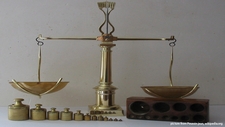Using a Balance

TEKS Objective
The student is expected to collect, record, and compare information using tools, including computers, hand lenses, rulers, primary balances, plastic beakers, magnets, collecting nets, notebooks, and safety goggles; timing devices, including clocks and stopwatches; weather instruments such as thermometers, wind vanes, and rain gauges; and materials to support observations of habitats of organisms such as terrariums and aquariums.
Essential Understanding
The student uses age-appropriate tools and models to investigate the natural world.
Science Background
Primer Balance Activity Guide: Ohaus Corporation (PDF) - Second grade students are not learning about measurement using standard units. They are, however, investigating how heavy or light something is, and comparing the weights of different objects, sometimes through the use of balance scale. Teachers will find that this activity guide provides excellent background information about the construction of a double pan balance, and how it works.
Primer Balance Activity Guide
Ohaus Corporation, www.ohaus.com
Mass vs. Weight: NASA (video) - Build your understanding of the difference between mass and weight with this video produced on the International Space Station.
Signature Lesson
Keeping in Balance: NCTM Illuminations (website) - Students balance pairs of like and unlike objects.
- Supporting Lessons
- Extensions
- Assessment Ideas
- Literature Connections
- Related
TEKS - Additional Resources
Supporting Lessons
How Much Does it Weigh? Vermillion Parish (LA) School District (website) - Students predict, measure and compare the weight/mass and volume of different solids and liquids using observation and a primary balance.
How Much Does it Weigh?
Vermillion Parish (LA) School District
Elaboration Lessons and Extensions
Keeping in Balance: Illuminations (website) - Students balance pairs of like and unlike objects by changing items’ distance from the fulcrum. They also record observations about the positions of the objects on the balance and identify patterns in their work.
Keeping in Balance
Illuminations, Illuminations.nctm.org
The Weight of Things: Illuminations (website) - Focus students’ attention on the attributes of weight and mass as they practice using a balance to measure and compare objects’ weight, in both standard and non-standard units.
Assessment Ideas
Have each student bring five objects from home and use a balance to rank the objects by mass.
Literature Connections
You Can Use a Balance. Bullock, Linda (ISBN-13: 978-0516278995)
Millions to Measure. Schwartz, D. (ISBN-13: 978-0060848064)
Weighing the Elephant. Ting-xing, Ye (ISBN-13: 978-1550375275)
Additional Resources
Poddle Weigh In: PBS Kids (website) - This interactive game challenges student to determine the mass of different creatures, called “poddles,” using a virtual balance scale.
Poddle Weigh In
PBS Kids, www.pbskids.org
TEKS Navigation
Grade 2
Need Assistance?
If you need help or have a question please use the links below to help resolve your problem.

Comments